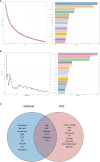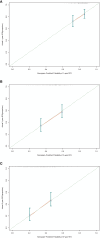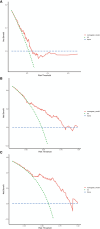Machine learning-based model for predicting tumor recurrence after interventional therapy in HBV-related hepatocellular carcinoma patients with low preoperative platelet-albumin-bilirubin score
- PMID: 38863693
- PMCID: PMC11165108
- DOI: 10.3389/fimmu.2024.1409443
Machine learning-based model for predicting tumor recurrence after interventional therapy in HBV-related hepatocellular carcinoma patients with low preoperative platelet-albumin-bilirubin score
Abstract
Introduction: This study aimed to develop a prognostic nomogram for predicting the recurrence-free survival (RFS) of hepatitis B virus (HBV)-related hepatocellular carcinoma (HCC) patients with low preoperative platelet-albumin-bilirubin (PALBI) scores after transarterial chemoembolization (TACE) combined with local ablation treatment.
Methods: We gathered clinical data from 632 HBV-related HCC patients who received the combination treatment at Beijing You'an Hospital, affiliated with Capital Medical University, from January 2014 to January 2020. The patients were divided into two groups based on their PALBI scores: low PALBI group (n=247) and high PALBI group (n=385). The low PALBI group was then divided into two cohorts: training cohort (n=172) and validation cohort (n=75). We utilized eXtreme Gradient Boosting (XGBoost), random survival forest (RSF), and multivariate Cox analysis to pinpoint the risk factors for RFS. Then, we developed a nomogram based on the screened factors and assessed its risk stratification capabilities and predictive performance.
Results: The study finally identified age, aspartate aminotransferase (AST), and prothrombin time activity (PTA) as key predictors. The three variables were included to develop the nomogram for predicting the 1-, 3-, and 5-year RFS of HCC patients. We confirmed the nomogram's ability to effectively discern high and low risk patients, as evidenced by Kaplan-Meier curves. We further corroborated the excellent discrimination, consistency, and clinical utility of the nomogram through assessments using the C-index, area under the curve (AUC), calibration curve, and decision curve analysis (DCA).
Conclusion: Our study successfully constructed a robust nomogram, effectively predicting 1-, 3-, and 5-year RFS for HBV-related HCC patients with low preoperative PALBI scores after TACE combined with local ablation therapy.
Keywords: extreme gradient boosting (Xgboost); hepatitis B virus (HBV); hepatocellular carcinoma (HCC); nomogram; random survival forest (RSF); recurrence-free survival (RFS).
Copyright © 2024 Wang, Sheng, Xiong, Han, Jin and Hu.
Conflict of interest statement
The authors declare that the research was conducted in the absence of any commercial or financial relationships that could be construed as a potential conflict of interest.
Figures








Similar articles
-
Nomogram for predicting post-therapy recurrence in BCLC A/B hepatocellular carcinoma with Child-Pugh B cirrhosis.Front Immunol. 2024 May 10;15:1369988. doi: 10.3389/fimmu.2024.1369988. eCollection 2024. Front Immunol. 2024. PMID: 38799452 Free PMC article.
-
Prognostic model for predicting recurrence in hepatocellular carcinoma patients with high systemic immune-inflammation index based on machine learning in a multicenter study.Front Immunol. 2024 Sep 9;15:1459740. doi: 10.3389/fimmu.2024.1459740. eCollection 2024. Front Immunol. 2024. PMID: 39315112 Free PMC article.
-
Albumin-Bilirubin and Platelet-Albumin-Bilirubin Grades Accurately Predict Overall Survival in High-Risk Patients Undergoing Conventional Transarterial Chemoembolization for Hepatocellular Carcinoma.J Vasc Interv Radiol. 2017 Sep;28(9):1224-1231.e2. doi: 10.1016/j.jvir.2017.05.020. Epub 2017 Jul 6. J Vasc Interv Radiol. 2017. PMID: 28688815
-
Preoperative platelet-albumin-bilirubin grades predict the prognosis of patients with hepatitis B virus-related hepatocellular carcinoma after liver resection: A retrospective study.Medicine (Baltimore). 2018 Mar;97(12):e0226. doi: 10.1097/MD.0000000000010226. Medicine (Baltimore). 2018. PMID: 29561452 Free PMC article.
-
The CMLA score: A novel tool for early prediction of renal replacement therapy in patients with cardiogenic shock.Curr Probl Cardiol. 2024 Dec;49(12):102870. doi: 10.1016/j.cpcardiol.2024.102870. Epub 2024 Sep 27. Curr Probl Cardiol. 2024. PMID: 39343053 Review.
Cited by
-
Applications of artificial intelligence in interventional oncology: An up-to-date review of the literature.Jpn J Radiol. 2025 Feb;43(2):164-176. doi: 10.1007/s11604-024-01668-3. Epub 2024 Oct 2. Jpn J Radiol. 2025. PMID: 39356439 Free PMC article. Review.
-
The EZ-ALBI and PALBI scores contribute to the clinical application of ALBI in predicting postoperative recurrence of HCC.Sci Rep. 2025 Mar 17;15(1):9132. doi: 10.1038/s41598-025-93716-9. Sci Rep. 2025. PMID: 40097642 Free PMC article.
-
Triglyceride-glucose index predicts postoperative overall survival in hepatocellular carcinoma: a retrospective cohort study.Discov Oncol. 2024 Nov 13;15(1):651. doi: 10.1007/s12672-024-01541-9. Discov Oncol. 2024. PMID: 39537878 Free PMC article.
References
MeSH terms
Substances
LinkOut - more resources
Full Text Sources
Medical
Miscellaneous

